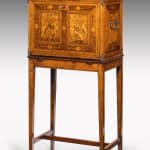17th Century Marquetry Fall Front Cabinet on Stand
The veneered stand circa 1790
45 ¼ x 20 ¼ x 13 ½ in
Further images
-
(View a larger image of thumbnail 1
)

-
(View a larger image of thumbnail 2
)

-
(View a larger image of thumbnail 3
)

-
(View a larger image of thumbnail 4
)

-
(View a larger image of thumbnail 5
)

-
(View a larger image of thumbnail 6
)

-
(View a larger image of thumbnail 7
)

-
(View a larger image of thumbnail 8
)

-
(View a larger image of thumbnail 9
)

-
(View a larger image of thumbnail 10
)

-
(View a larger image of thumbnail 11
)

The cabinet of rectangular form, with a fall front, revealing a collection of drawers. The front is inlaid with two panels, each with a songbird perched on a leafy branch within borders of scrolling and geometric marquetry. The inside of the fall front is inlaid with a bird before a cityscape surrounded by a chequered strung outer border, encompassing scrolling foliage with flowers and trompe-l'œil pierced scroll motifs. The interior arrangement of two long and five short drawers each inlaid with a bird perched in a tree before a cityscape. The central door opens to reveal one long and six short drawers, which can be removed to reveal a secret compartment containing four hidden drawers. On the reverse there is some unclear Old German script which reads: ‘Made by a cabinet maker [in or from] Saint Blasier. Brought to Schwanwald, near Lutsliegh [or Liechtenstein].’ There is a date – ‘30 March’- and it includes the comment: ‘How long I have been working on this big task you would not believe it.’ The text suggests that this cabinet is either the work of an apprentice, used to demonstrate an apprentice’s skills or a piece to demonstrate teaching skills.
From the middle of the 16th Century, Augsburg had witnessed an extraordinary ascendency as a centre of furniture production for the international market, a new phenomenon at the time. 16th Century Augsburg marquetry almost invariably depicted fictional cityscapes. 16th Century marquetry of this kind remained highly popular throughout later ages and was frequently adapted to new uses. Tyrol was inspired by Augsburg cabinets.
In her book ‘Der Wrangelschrank und die verwandten süddeutschen Intarsienmöbel des 16. Jahrhunderts’ (Deutscher Verein für Kunstwissenschaft, 1956), Lieselotte Möller discusses 16th Century inlaid furniture from South Germany. She illustrates a number of ‘Schreibkästchen’ and ‘Schreibtisch’ (‘writing caskets’ and ‘writing tables’), which bear similar designs to this cabinet. (figs. 132, 138, 173, 185).











